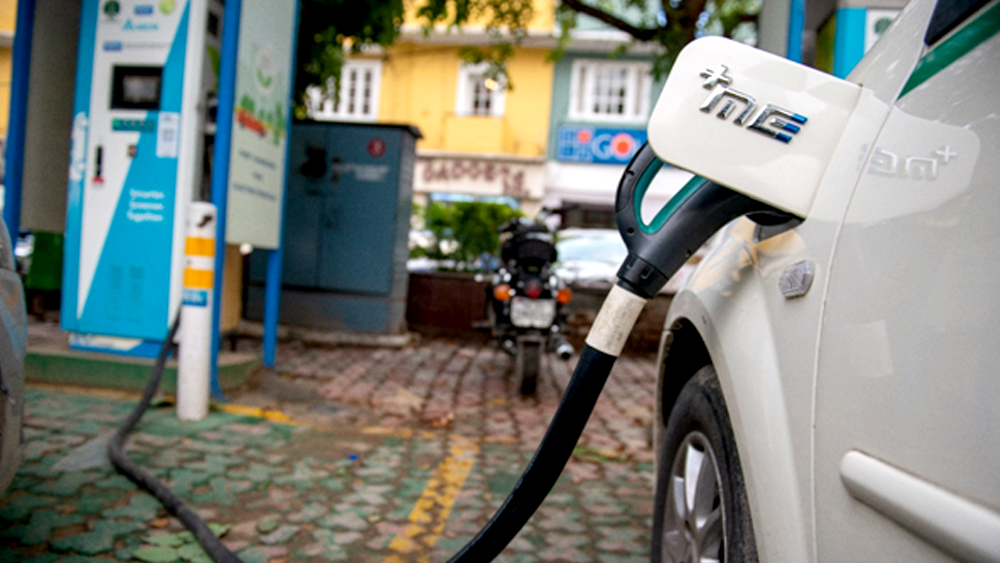On the Road to a Green Future: Making the Electric Vehicle Life Cycle Better

In the previous blog, we discussed how the energy life cycle needs to be enhanced for sustainable development. In this article, we look into another key aspect of sustainability:, creating environment-friendly mobility systems that do not rely on fossil fuels for their energy. Primary among such mobility systems are electric vehiclesbacked by a renewables-based power supply system.
As nations shift their focus to environmental well-being, mitigating climate-change, and achieving carbon neutrality, electric vehicle (EV) use is expected to grow substantially.
In India, too, electric vehiclesare becoming mainstream and can be found in various sectors such as in e-commerce logistics, fleet operations, and the railroad industry. In 2021, there were over 3 lakh registered EVs in India.
The Indian government is incentivizing further EV manufacturing and adoption through different policies such as FAME (Faster Adoption and Manufacturing of hybrid and Electric vehicles) and Production Linked Incentives Schemes (PLI). Many big automobile manufacturing companies have adapted their existing manufacturing platforms to also include EV’s, and multiple start-ups have entered the EV space, offering various products and services such as EV fleets, charging stations, battery swapping, and component manufacturing. These companies are also working to localise their supply chains and reduce their dependence on imports,to keep the nation’s trade deficit in check.
However, aswe hurtle towards the adoption of EVs, we must pause to ask:EVs may be greener than conventional fossil-fuelled vehicles, but is there scope to make EVsmore sustainable?
To answer this question, what is needed is a comprehensive life cycle analysis of the EV industry. This involves evaluating the environmental impacts of EVsacross the value chain,and considering ways of making each stage of this value chains more sustainable.
Raw materials
A wide pool of raw materials, including iron (steel), aluminum, nickel, copper, cobalt, and lithium, are used to manufacture EVs. The extraction of these can be environmentally detrimental and resource intensive. Further, asmany of these are scarce resources and rare earth elements, their economically viable natural reserves couldbe exhausted within as short a span of time as a decade, given the current trend of rising demand forEV’s.
Thus, several measures will be key to reducing the environmental footprint here: i).material recycling to reduce mining and extraction; ii) research to replace these materials with more widely available materials;iii).implementation of more efficient mining practices; and iv) location of manufacturing units closer to the raw material or to recycling sites to avoid pollution from transportation.
Among these measures, research for more widely available materials has seen some success and yielded several promising alternatives, such as graphene for energy storage and alternate battery chemistries, which reduce the dependence of the EV industry on rare earth elements.
Manufacturing
In this stage, raw materials are put together to produce the consumer-ready EV.As all manufacturing technologiesfor EVsare still new, the key focus area for researchers and innovators at this stage has beenthe vehicle itself, including aspects such as vehicle design and improved powertrain technology.
Start-ups like Lightyear have taken on the task of enhancing vehicle design and aspects of vehicle performance, such reducing air drag, bettering powertrain, and making energy systems more efficient. Companies like Tesla and Chara motors are building synchronous reluctance motor technologies, which are free of rare-earth metal-based permanent magnets and are, thus, a more sustainable alternative to the currently used traction motors.
Moreover, carbon footprint is a key challenge here as well; for instance, the battery-manufacturing process in EVs generates more carbon than that in conventional vehicles,and the energy grid powering EV manufacturing may not be based on renewables.
This is augmented by the fact that government policies and regulations can also have a large impact on sustainable practices in the sector overall. For example, one estimate finds that, due to differences in regulations, EVbattery manufacturing in China can have 60% to 85% higher carbon dioxide emissions than manufacturing in the European Union or the United States. India’s budding policies in this sector must take cues from these findings.
Sales and Services
Unlike the process of extracting raw materials and the manufacturing stage, EV use, the third stage in the EV life cycle,appears to be highly environment-friendly because EVsdo not emit any greenhouse gases(GHGs).But EVscan become less sustainable indirectly when they depend on charging stations powered by fossil-fuel-based electricity. For EVs to successfully reduce overall GHG emissions, power supply systems will have to make a parallel transition to renewable energy-based electricity generation. This provides another area of focus for innovators eager to be a part of the EV revolution.Further, infrastructure-building initiatives such as creating battery-swapping units (a key focus in India’s Union Budget for 2022–2023) also require extensive research and,innovation and, standardizationbetween different original equipmentmanufacturers—to succeed.
But while EVs require infrastructural support to remain sustainable once in use, owing to their design, they already are more sustainable than conventional vehicles. This is because unlike conventional vehicles whose powertrains have over 2000 moving parts, which require regular replacement, lubrication, and maintenance, EV powertrains have only about 20 moving parts. This reduces the need for regular maintenance or the use of consumables such as lubricants. So, if component manufacturing becomes sustainable, EV’s will automatically be lot more sustainable than current forms of mobility.
Decommissioning
The overall life expectancy of EV’s is similar to that of conventional vehicles(~20 years).,But the challenge is that EV components are more environmentally toxic at the end of life than their counterparts in conventional vehicles.
Scientists and engineers are working on improving EV component materials and their resilience, and consumers are being sensitised regarding EV-friendly driving and charging practices, to prolong EV lifespans. Yet, this is not enough. Recycling infrastructure designed to process EV components with maximum efficiency at the end of life of a vehicle must be established.
Overall, India’s EV sector is at a nascent stage. But even in places like China, Europe, and the United States, where EV use is miles ahead, one key aspect of infrastructure to truly scale EVs remains to be adequately built: recycling. This will be crucial for a meaningful global transition to the EV age.
In addition, simultaneously transitioning to a renewables-based energy grid is the only way to ensure that the true carbon footprint of an EV transition is lower than that of our current society.
Stay tuned to understand where we are with this energy grid greening process and how that transition will feed into the EV transition.





